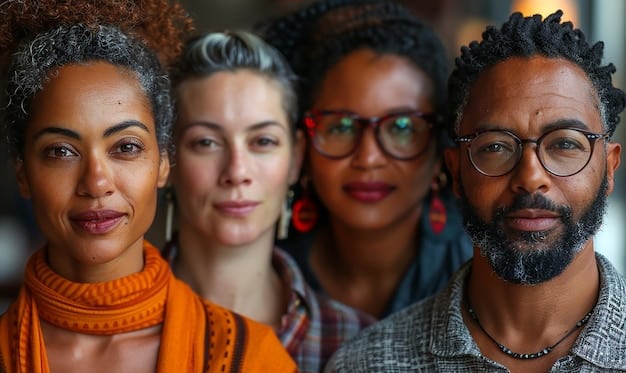Building Bridges: Practical Steps for Community Inclusion & Diversity

Building Bridges in communities involves practical steps like promoting awareness, engaging diverse groups, implementing inclusive policies, and supporting community initiatives to ensure everyone feels valued and respected.
Building Bridges: Practical Steps to Foster Inclusion and Diversity in Your Community is more than just a phrase; it’s a call to action. In a world becoming increasingly interconnected, creating communities where everyone feels valued, respected, and empowered is vital. This article explores actionable strategies to achieve this goal, helping you build a more inclusive and diverse community.
Understanding the Importance of Inclusion and Diversity
Before diving into the practical steps, it’s essential to understand why inclusion and diversity are so crucial. These aren’t just buzzwords; they represent core values that strengthen the fabric of our communities. When everyone has a seat at the table, we benefit from a wealth of perspectives, experiences, and ideas.
A diverse community is a resilient community. It’s better equipped to handle challenges, adapt to change, and innovate. Furthermore, inclusion ensures that all members have equal access to opportunities, resources, and support. This levels the playing field and creates a more equitable society.

The Benefits of Diversity and Inclusion
Embracing diversity and inclusion offers numerous tangible benefits to a community. These benefits extend beyond ethical considerations, impacting economic growth, social cohesion, and overall well-being.
- Economic Growth: Diverse communities attract businesses and investment, fostering innovation and creating job opportunities for residents.
- Improved Problem-Solving: Different perspectives lead to more creative and effective solutions to community challenges.
- Stronger Social Bonds: Inclusion promotes empathy and understanding, leading to stronger relationships and reduced social divisions.
- Enhanced Reputation: Communities known for their inclusivity attract new residents, businesses, and visitors, enhancing their overall reputation.
By cultivating an environment where differences are valued rather than feared, communities can unlock their full potential and thrive in an increasingly interconnected world. Investing in diversity and inclusion is an investment in the future.
Assessing Your Community’s Current Landscape
Before implementing any strategies, it’s crucial to conduct an honest assessment of your community’s current landscape. This involves identifying areas where inclusion and diversity are lacking and understanding the challenges hindering progress. Open dialogue and data collection are essential for this process.
Start by examining the demographics of your community. Are all groups represented in positions of leadership? Are there disparities in access to resources or opportunities? Are there any historical or systemic factors that contribute to these disparities?
Gathering Community Feedback
Collecting community feedback is a vital step in the assessment process. This involves engaging diverse groups and individuals to understand their experiences, perspectives, and concerns. There are several effective methods for gathering this information.
- Surveys: Conduct surveys to collect quantitative data on residents’ perceptions of inclusion and diversity.
- Focus Groups: Organize focus groups with representatives from different community groups to gather qualitative data and in-depth insights.
- Community Forums: Host community forums where residents can voice their opinions, share their stories, and participate in open discussions.
- One-on-One Interviews: Conduct individual interviews with key stakeholders, such as community leaders, business owners, and residents, to gain a deeper understanding of their perspectives.
By actively seeking and listening to community feedback, leaders can gain a comprehensive understanding of the challenges and opportunities related to inclusion and diversity.
Promoting Awareness and Education
One of the most effective ways to foster inclusion and diversity is by promoting awareness and education. This involves raising awareness about the importance of these values, challenging stereotypes, and educating people about different cultures, perspectives, and experiences.
Education initiatives can take many forms, from workshops and seminars to public awareness campaigns. The goal is to create a more informed and understanding community that is better equipped to address issues of prejudice and discrimination. By teaching people about the benefits of inclusion and diversity, you can create a more welcoming and accepting environment for all.
Implementing Educational Programs
Implementing targeted educational programs is a proactive approach to promote awareness and understanding within the community. These programs can be tailored to address specific needs and target different groups.
- Diversity Training: Offer diversity training workshops for community leaders, business owners, and employees to promote cultural sensitivity and understanding.
- Cultural Exchange Programs: Organize cultural exchange programs to allow residents to learn about different cultures and traditions firsthand.
- Guest Speakers: Invite guest speakers from diverse backgrounds to share their stories and experiences with the community.
- Film Screenings and Discussions: Host film screenings and discussions that explore themes related to diversity, inclusion, and social justice.
Educational programs provide opportunities for personal growth, empathy development, and a deeper understanding of the complexities of diversity and inclusion. Education is a powerful tool for building bridges and fostering a more equitable community.
Creating Inclusive Policies and Practices
Inclusion and diversity should be embedded in every aspect of community life, from local government policies to business practices. Creating inclusive policies ensures that all residents have equal access to opportunities and resources, regardless of their background or identity.
Review existing policies to identify areas where they may unintentionally exclude or disadvantage certain groups. Consult with diverse community groups to ensure that policies are fair, equitable, and responsive to their needs. Enforce these policies consistently and transparently.

Examples of Inclusive Policies
Inclusive policies can take various forms, addressing different aspects of community life. Below are some examples of policies that can promote inclusion and diversity.
- Equal Employment Opportunity: Implement policies that prohibit discrimination based on race, gender, religion, sexual orientation, or other protected characteristics.
- Accessible Public Spaces: Ensure that all public spaces, such as parks, libraries, and community centers, are accessible to people with disabilities.
- Language Accessibility: Provide translation and interpretation services for residents who do not speak English.
- Affordable Housing: Develop policies to increase the availability of affordable housing options for low-income residents.
By creating inclusive policies, communities can foster a more equitable society where everyone has the opportunity to thrive. Policies send a clear message that diversity is valued and that discrimination will not be tolerated.
Engaging Diverse Groups in Decision-Making
True inclusion means giving diverse groups a voice in the decision-making processes that affect their lives. This requires actively seeking out and listening to the perspectives of underrepresented groups, and ensuring that their voices are heard at all levels of community governance.
Establish advisory committees that represent the diversity of your community. Invite members of these committees to participate in policymaking discussions. Create opportunities for residents to provide feedback on proposed policies and initiatives.
Strategies for Effective Engagement
Engaging diverse groups in decision-making requires a thoughtful and strategic approach. It’s not enough to simply invite people to the table; you must create an environment where they feel comfortable sharing their perspectives and that their voices are valued.
- Outreach and Recruitment: Actively recruit diverse candidates for advisory committees and leadership positions.
- Accessible Communication: Communicate information in multiple languages and formats to ensure that it is accessible to all residents.
- Facilitation Skills: Train meeting facilitators to be sensitive to cultural differences and to create an inclusive environment for discussion.
- Feedback Mechanisms: Establish feedback mechanisms, such as online surveys and suggestion boxes, to gather input from residents who are unable to attend meetings.
By empowering diverse groups to participate in decision-making, communities can create more effective and equitable policies that reflect the needs and desires of all residents. Inclusive decision-making leads to better outcomes and stronger community bonds.
Supporting Community Initiatives and Organizations
Many community initiatives and organizations are already working to promote inclusion and diversity at the grassroots level. Supporting these efforts can amplify their impact and create a more collaborative and cohesive community.
Provide funding and resources to organizations that serve diverse populations. Partner with these organizations to develop joint programs and initiatives. Recognize and celebrate the contributions of individuals and groups who are working to build a more inclusive community.
Examples of Community Initiatives
A wide range of community initiatives and organizations are working to promote inclusion and diversity. Here are a few examples of the types of initiatives you can support.
- Mentorship Programs: Support mentorship programs that connect young people from diverse backgrounds with adult role models.
- Community Gardens: Create community gardens where residents from different cultures can grow their own food and share their traditions.
- Cultural Festivals: Organize cultural festivals that celebrate the diversity of the community and provide opportunities for cross-cultural exchange.
- Language Classes: Offer language classes for residents who want to learn a new language and connect with people from different linguistic backgrounds.
By supporting community initiatives, you can empower residents to take ownership of the building bridges process and create a more inclusive society from the ground up. Local initiatives are often the most effective way to address the specific needs and challenges of a community.
Evaluating Progress and Adapting Strategies
Promoting inclusion and diversity is an ongoing process, not a one-time event. It’s essential to regularly evaluate progress and adapt strategies based on the results. This ensures that efforts remain effective and responsive to the changing needs of the community.
Track key indicators, such as representation rates in leadership positions, participation rates in community programs, and resident satisfaction levels. Collect feedback from diverse groups to understand their experiences and identify areas for improvement. Use this information to refine strategies and make course corrections as needed.
Continuous Improvement
Continuous improvement is a mindset that embraces change, learning, and innovation. It emphasizes the importance of regularly reviewing and refining processes to achieve better outcomes.
- Data Analysis: Analyze data to identify trends, patterns, and areas where progress is lagging.
- Stakeholder Feedback: Gather feedback from stakeholders to understand their perspectives on the effectiveness of current strategies.
- Best Practices Research: Research best practices from other communities to identify innovative approaches to promoting inclusion and diversity.
- Pilot Programs: Implement pilot programs to test new strategies and gather data on their effectiveness before scaling them up.
By embracing a culture of continuous improvement, communities can ensure that their efforts to promote inclusion and diversity are always evolving and adapting to meet the challenges of a changing world. This requires a commitment to learning, collaboration, and a willingness to challenge the status quo.
| Key Point | Brief Description |
|---|---|
| 🤝 Community Assessment | Evaluate diversity and inclusion gaps through open dialogue and data. |
| 📚 Education Programs | Implement training and cultural exchanges to raise awareness. |
| 🏛️ Inclusive Policies | Create fair policies ensuring equal access and eliminate discrimination. |
| 🗣️ Diverse Engagement | Engage diverse voices in community decision-making processes. |
FAQ
▼
Community inclusion involves ensuring that all individuals, regardless of their background or identity, have equal opportunities to participate in community life and access resources, programs, and services.
▼
Diversity brings different perspectives, experiences, and ideas to a community. This enhances problem-solving, fosters innovation, promotes cultural understanding, and strengthens social bonds among residents from different backgrounds.
▼
You can promote it by sharing information on social media, attending community events, and learning about different people and cultures. You can also invite friends, family and coworkers to learn more about the topic.
▼
Examples include equal employment opportunity policies, accessible public spaces for people with disabilities, language accessibility services for non-English speakers, and affordable housing initiatives for low-income residents to thrive in the community.
▼
You can engage diverse groups by inviting members from them at town hall meetings and asking them about their opinions. You can also invite them to join boards or committees and ensure their views are heard and respected during community decisions.
Conclusion
Building Bridges: Practical Steps to Foster Inclusion and Diversity in Your Community is a collective effort that requires ongoing commitment, collaboration, and a willingness to challenge the status quo. By implementing the strategies outlined in this article, you can create a more inclusive and equitable community where everyone feels valued, respected, and empowered to reach their full potential.





